Evolution and Construction Differentiation Pattern of African Railway Network
Abstract
:1. Introduction
2. Study Area and Data
2.1. Study Area
2.2. Date Sources
3. Evolution of African Railway Network Pattern
3.1. Evolution Stages
- (1)
- The first stage
- (2)
- The second stage
- (3)
- The third stage
3.2. Spatial Mode
- (1)
- “Hinterland-Port” mode
- (2)
- “Overall Integration” mode
4. Differentiation of Railway Construction in Africa
4.1. Contractor Country
4.2. Contractor Enterprise
- (1)
- One-one Mode
- (2)
- Multiple-one Mode
- (3)
- Multiple-multiple Mode
5. Conclusions and Discussion
Author Contributions
Funding
Institutional Review Board Statement
Informed Consent Statement
Data Availability Statement
Conflicts of Interest
References
- Jin, F.; Wang, C.; Li, X.; Wang, J. China’s regional transport dominance: Density, proximity, and accessibility. J. Geogr. Sci. 2010, 20, 295–309. [Google Scholar] [CrossRef]
- Debrie, J. From colonization to national territories in continental West Africa: The historical geography of a transport infrastructure network. J. Transp. Geogr. 2010, 18, 292–300. [Google Scholar] [CrossRef]
- Wang, J.; Du, F.; Wu, M.; Liu, W. Embedded technology transfer from an institution and culture nexus perspective: Experiences from the Mombasa-Nairobi Standard-Gauge Railway. J. Geogr. Sci. 2021, 31, 681–698. [Google Scholar] [CrossRef]
- Wang, C.; Xie, Y.; Chen, P. Institutional-economic-cultural adaptability of overseas railway construction: A case study of Addis Ababa-Djibouti Railway. Acta Geogr. Sin. 2020, 75, 1170–1184. [Google Scholar]
- Lin, G.C.S. Transportation and metropolitan development in China’s Pearl River Delta: The experience of Panyu. Habitat Int. 1999, 23, 249–270. [Google Scholar] [CrossRef]
- Linneker, B.; Spence, N. Road transport infrastructure and regional economic development: The regional development effects of the M25 London orbital motorway. J. Transp. Geogr. 1996, 4, 77–92. [Google Scholar] [CrossRef]
- Zhong, Y.; Wang, X.; Fu, Y. Regional development imbalance of the “Min-Xin Axis Belt”. Econ. Geogr. 2018, 38, 22–29. [Google Scholar]
- Feng, C.; Feng, X.; Liu, S.J. Effects of high speed railway network on the inter-provincial accessibilities in China. Prog. Geogr. 2013, 32, 1187–1194. [Google Scholar]
- Liu, B.; Wu, W.; Su, Q. Spatio-temporal evolution characteristics and mechanism of railway efficiency in China. Geogr. Res. 2018, 37, 512–526. [Google Scholar]
- Chen, C.L. Reshaping Chinese space-economy through high-speed trains: Opportunities and challenges. J. Transp. Geogr. 2012, 22, 312–316. [Google Scholar] [CrossRef]
- Preston, J. High speed rail in Britain: About time or a waste of time? J. Transp. Geogr. 2012, 22, 308–311. [Google Scholar] [CrossRef]
- Shaw, S.L.; Fang, Z.; Lu, S.; Tao, R. Impacts of high speed rail on railroad network accessibility in China. J. Transp. Geogr. 2014, 40, 112–122. [Google Scholar] [CrossRef]
- Jiang, H.B.; Zhang, W.Z.; Qi, Y.; Jiang, J. The land accessibility influenced by China’s high-speed rail network and travel cost. Geogr. Res. 2015, 34, 1015–1028. [Google Scholar]
- Liwen, L.; Ming, Z. The impacts of high speed rail on regional and spatial economy abroad and the enlightenment to China. Urban Plan. Int. 2018, 33, 95–100. [Google Scholar]
- Haibing, J.; Yi, Q.; Chuanwu, L. China’s city high-speed rail (HSR) passenger spatial linkage pattern and its influence factors. Econ. Geogr. 2018, 38, 26–33. [Google Scholar]
- Jiao, J.; Wang, J.; Jin, F.; Wang, H. Impact of high-speed rail on inter-city network based on the passenger train network in China, 2003–2013. Acta Geogr. Sin. 2016, 71, 265–280. [Google Scholar]
- Liu, C.; Xu, J.; Guo, Q. Spatial pattern of urban centrality on railway hub in China’s mainland. Econ. Geogr. 2019, 39, 57–66. [Google Scholar]
- Jiang, H.; Cai, H.; Meng, X. The structural impact of high speed rail upon urban industries in China. Hum. Geogr. 2017, 32, 132–138. [Google Scholar]
- Jin, F.; Jiao, J.; Qi, Y.; Yang, Y. Evolution and geographic effects of high-speed rail in East Asia: An accessibility approach. J. Geogr. Sci. 2017, 27, 515–532. [Google Scholar] [CrossRef] [Green Version]
- Wang, J.; Jiao, J. Development process, spatial pattern and effects of high-speed rail network in China. Trop. Geogr. 2014, 34, 275–282. [Google Scholar]
- Ministry of Foreign Affairs of the People’s Republic of China. China-Africa Poverty Reduction and Development Cooperation. 2017. Available online: www.fmprc.gov.cn/mfa_eng/ (accessed on 1 October 2021).
- Wang, W. Analysis of China-Africa infrastructure construction cooperation. Int. Proj. Contracting Labour Serv. 2016, 11, 51–52. [Google Scholar]
- Zheng, Y. Prospect of infrastructure construction in Africa and analysis of Chinese factors. J. Int. Econ. Coop. 2014, 6, 71–74. [Google Scholar]
- Shen, X. China’s Aid to Tan-Zan Railway: Its Consideration, Building Progress and Impacts; East China Normal University: Shanghai, China, 2009. [Google Scholar]
- Hu, Z. The past, present and future of Tan-Zan railway. Railw. Econ. Res. 2000, 2, 46–47. [Google Scholar]
- Zhang, L. Innovation of internationalized business model of enterprises from the experience of Ya-Ji Railway. Int. Proj. Contracting Labour Serv. 2019, 3, 47–50. [Google Scholar]
- Wei, X. Study of Risk Management of Africa Area Railway EPC Project: Take Kenny Mombasa-Nairobi Railway EPC Project for Example; Beijing University of Posts and Telecommunications: Beijing, China, 2013. [Google Scholar]
- Liu, D. The Research of “Angola Model”; Shanghai Normal University: Shanghai, China, 2016. [Google Scholar]
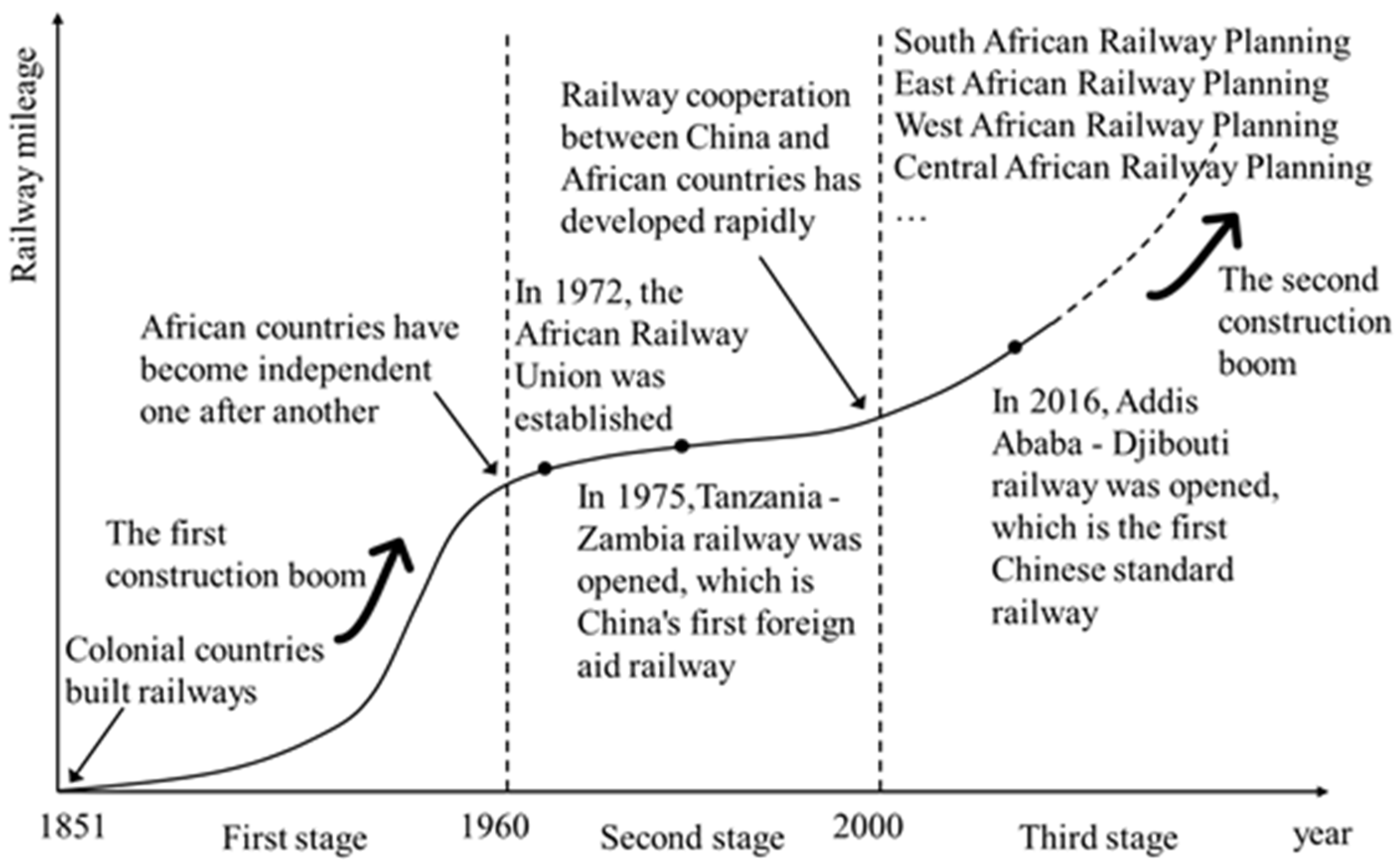
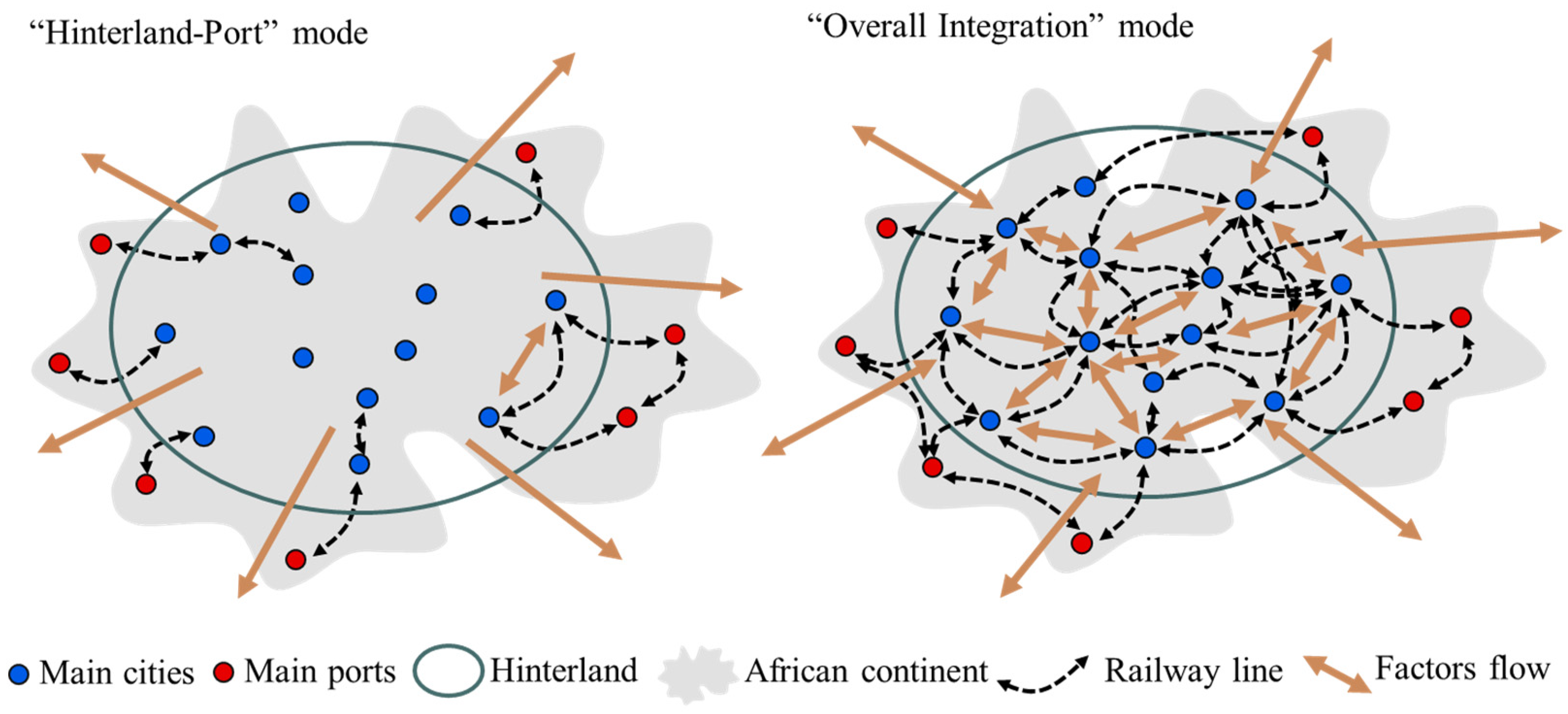
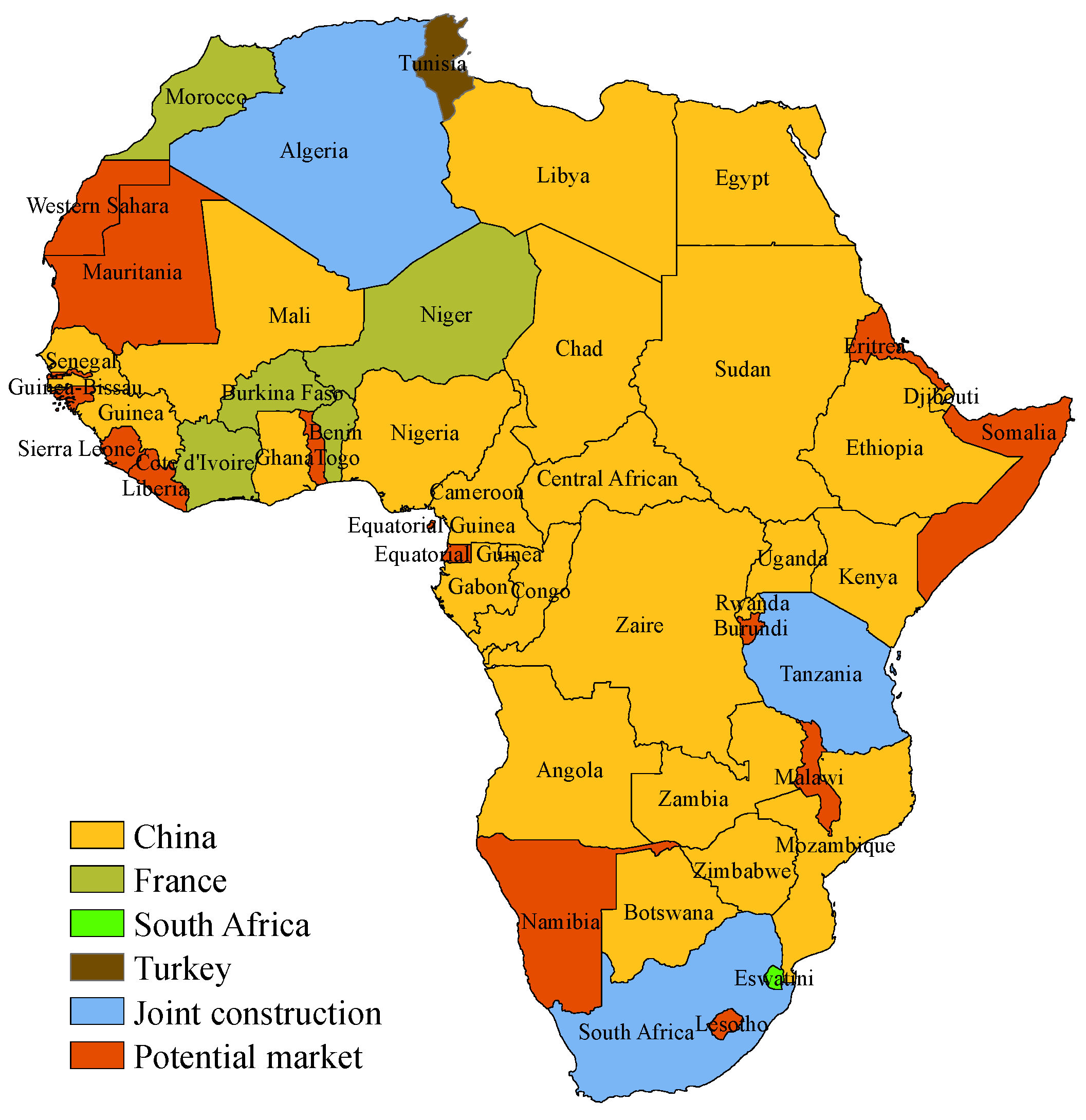
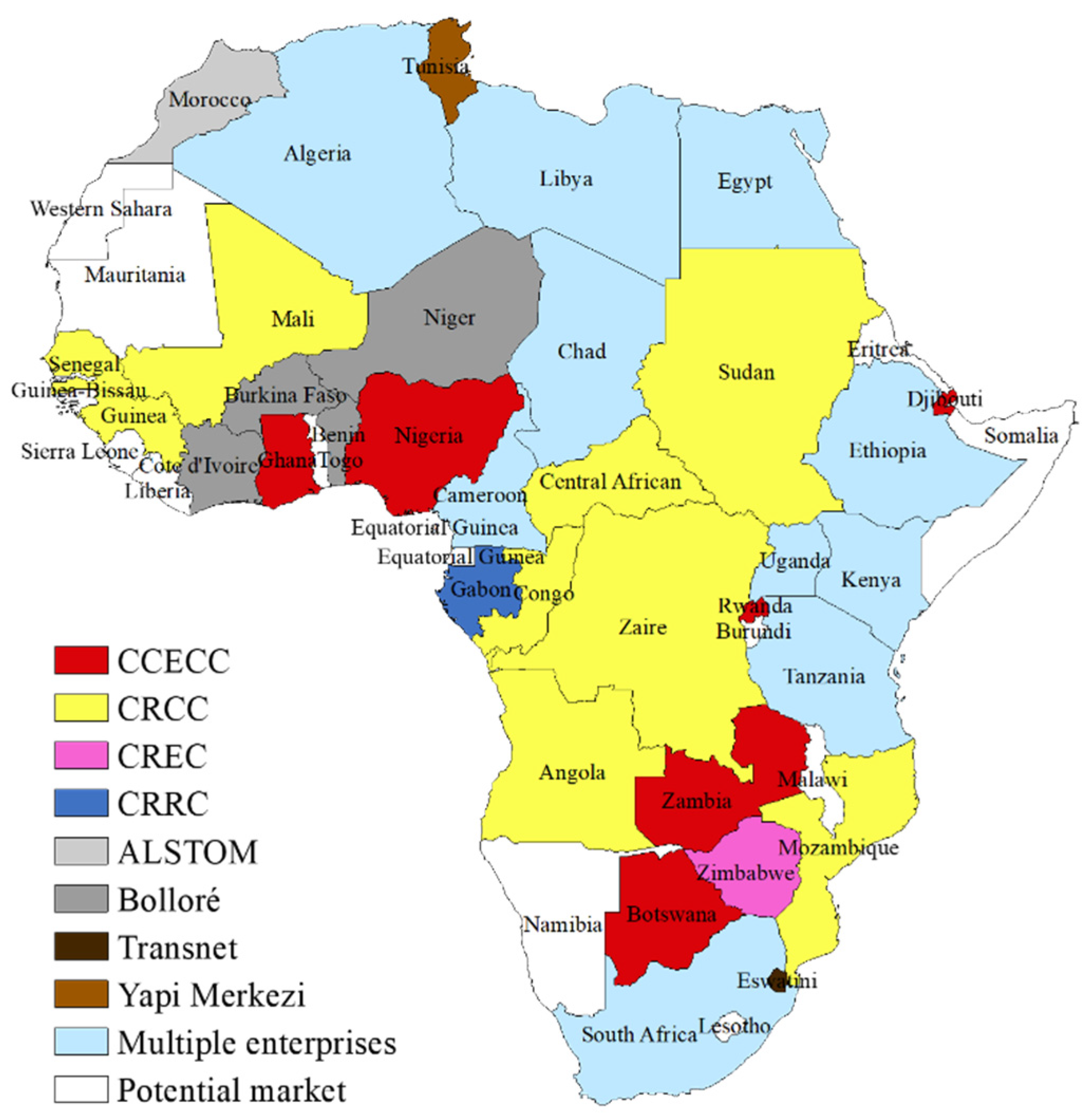
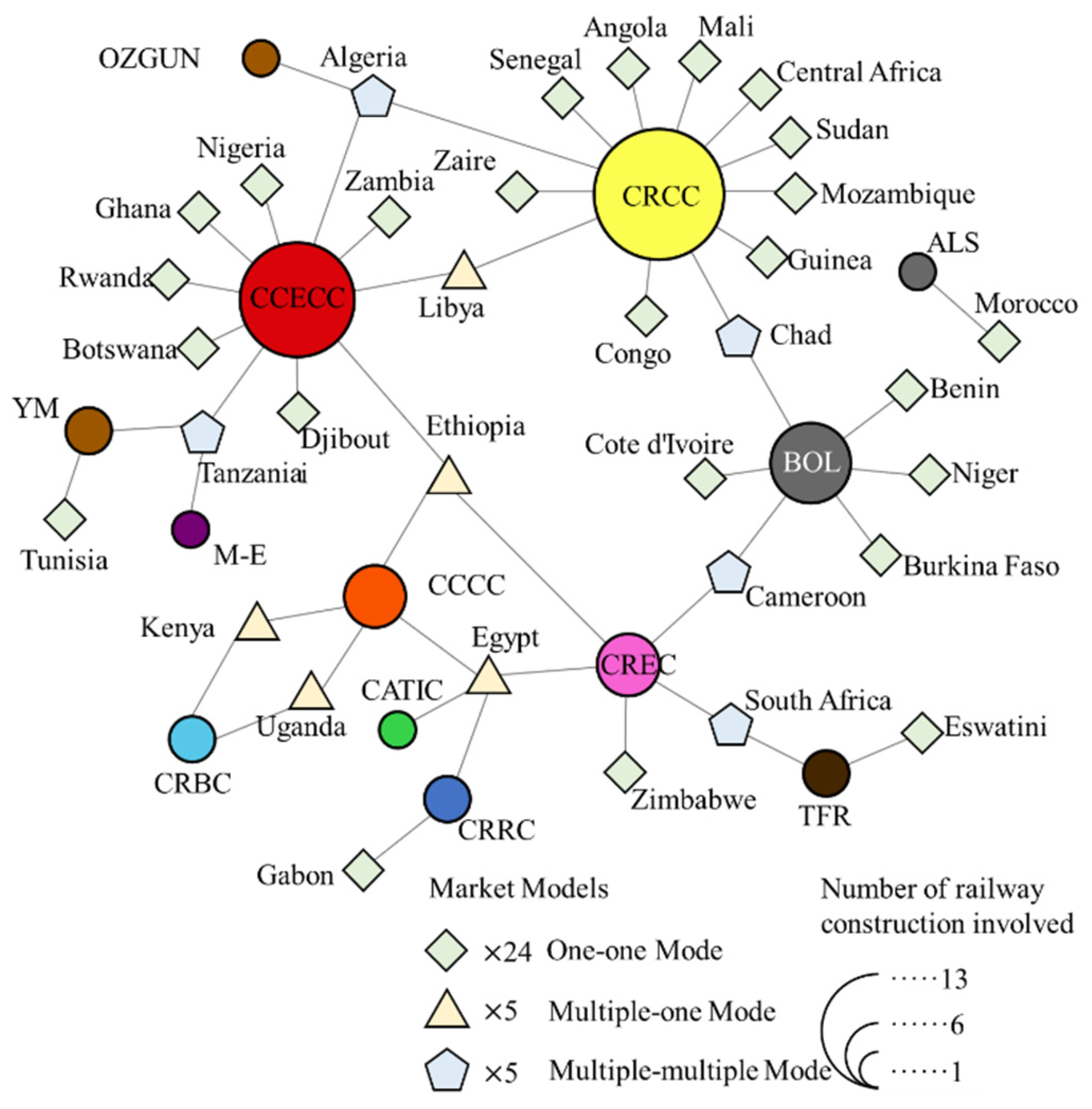

| Country | Mileage of Each Gauge/km | Country | Mileage of Each Gauge/km | ||
|---|---|---|---|---|---|
| 1435 mm | 1067 mm | 950 mm | 1000 mm | ||
| Liberia | 472 | Ethiopia | 721 | ||
| Angola | 3018 | Burkina Faso | 630 | ||
| Congo | 727 | Togo | 444 | ||
| Ghana | 888 | Djibouti | 479 | ||
| Nigeria | 3221 | Guinea | 821 | ||
| Sierra Leone | 75 | Cote d’Ivoire | 1135 | ||
| Sudan | 773 | Mali | 806 | ||
| Zambia | 505 | Senegal | 1409 | ||
| Zaire | 2720 | Tanzania | 2366 | ||
| Eritrea | 225 | Zaire | 463 | ||
Publisher’s Note: MDPI stays neutral with regard to jurisdictional claims in published maps and institutional affiliations. |
© 2021 by the authors. Licensee MDPI, Basel, Switzerland. This article is an open access article distributed under the terms and conditions of the Creative Commons Attribution (CC BY) license (https://creativecommons.org/licenses/by/4.0/).
Share and Cite
Xie, Y.; Wang, C. Evolution and Construction Differentiation Pattern of African Railway Network. Sustainability 2021, 13, 13728. https://doi.org/10.3390/su132413728
Xie Y, Wang C. Evolution and Construction Differentiation Pattern of African Railway Network. Sustainability. 2021; 13(24):13728. https://doi.org/10.3390/su132413728
Chicago/Turabian StyleXie, Yongshun, and Chengjin Wang. 2021. "Evolution and Construction Differentiation Pattern of African Railway Network" Sustainability 13, no. 24: 13728. https://doi.org/10.3390/su132413728
APA StyleXie, Y., & Wang, C. (2021). Evolution and Construction Differentiation Pattern of African Railway Network. Sustainability, 13(24), 13728. https://doi.org/10.3390/su132413728






